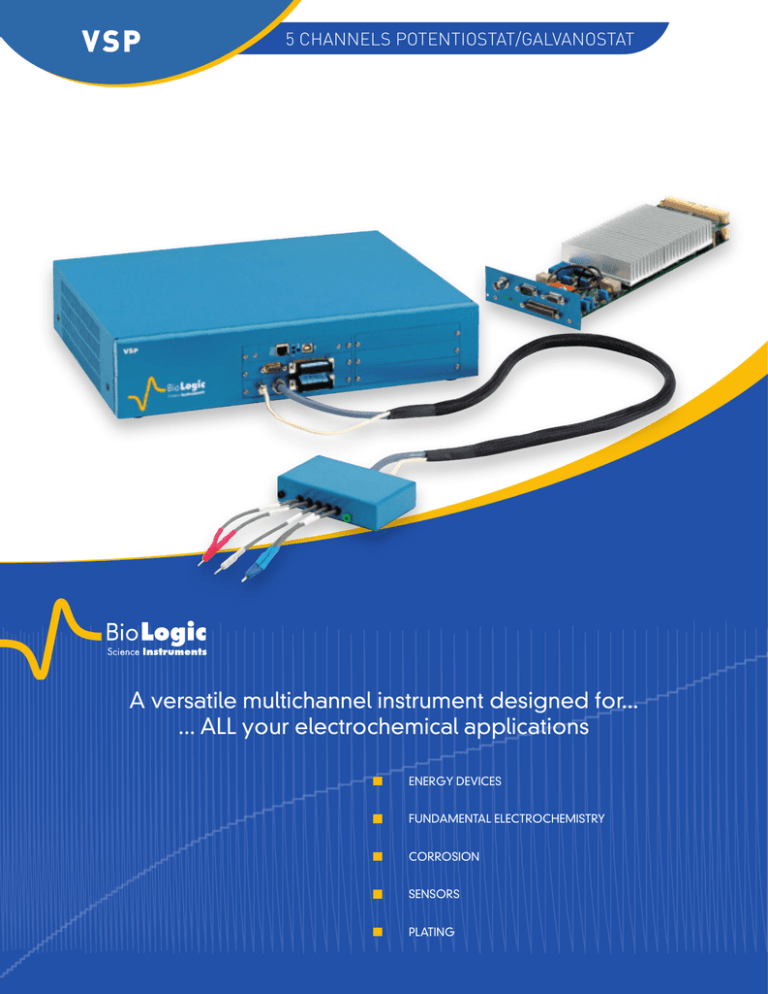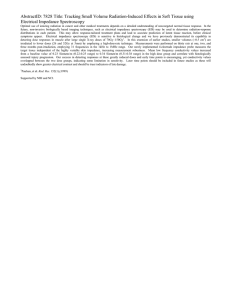A versatile multichannel instrument designed for... All your
advertisement

VSP 5 channels Potentiostat/Galvanostat A versatile multichannel instrument designed for... ... ALL your electrochemical applications Energy devices fundamental Electrochemistry Corrosion Sensors Plating The VSP is a modular potentiostat with research grade specifications. The VSP chassis offers five slots. They can be occupied by a wide range of options such as: a low current board, a 4 Amps booster, up to 5 potentiostat/ galvanostat board with or without EIS capability. Each potentiostat installed in the VSP can be connected to an external current booster channel (2, 5,10, 20, 80 or 100 amps). All this versatility, plus its ability to switch from potential control to current control in 10 µs, makes it the perfect choice for any electrochemical application. The VSP is controlled from a PC by a USB or an Ethernet connection. Using the Ethernet connection, the VSP can be installed on a Local Area Network to allow multiple users to access the instrument. Each channel has two analog inputs and an analog output to manage external instruments, such as a rotating electrode, or a quartz crystal microbalance, and record the generated data. The VSP is supplied with EC-Lab® software package. With over 70 techniques that can be sequenced, and with a variety of analysis tools, including EIS modeling with LevenbergMarcquardt and Simplex algorithms, the VSP is truly the ultimate electrochemical workstation. GENERAL SPECIFICATIONS Current ranging from 10 µA up to 1 A with a 760 pA resolution (76 fA on the 1 nA range of the low current option) 20 V adjustable reference voltage Resolution: 300 µV programmable down to 5 µV by adjusting the dynamic range Acquisition time: 200 µs Simultaneous EIS measurement on WE and CE electrodes* N’Stat mode to perform experiments with several working electrodes versatile options EIS option (10 µHz to 1 MHz) on each channel Low-current option (1 nA range) Up to 5 independent channels ±4 A built-in kit External boosters available from 2 A up to 100 A. Load boxes: 150 A@50 V. * With EIS option Potentiostat - Galvanostat applications Energy sources and storage Fundamental Electrochemistry The design and the performance of the VSP benefit from the long history of previous EC-Lab® instrument generations (MacPile and VMP) in the fields of intercalation compounds, battery and super-capacitors study. Many techniques are available for battery cycling in both current and potential control modes. Techniques are now available that allow the simultaneous evaluation of the different elements of a stack. Fundamental research in electrochemistry is one of the most demanding applications with respect to instrumentation. This type of research is aimed at exploring material limits, and therefore requires the most advanced instrument capabilities. The VSP is designed to help scientists perform critical research in electrochemistry such as electron transfer kinetic studies or electrochemical analysis of compounds at low trace levels. Fast potential scans can be used to highlight intermediate species of a reaction. For low current measurements, the excellent sensitivity of the VSP is a big advantage. sensors Corrosion Potentiometric sensors (ion selective electrodes) and amperometric sensors (thin film micro-electrodes or modified electrodes) require good sensitivity to low currents. The VSP, with its “low-current” option, offers a 76 fA resolution on the 1 nA current range. The multichannel capability of the VSP is an important feature in multi-sensor research applications requiring the use of DNA chips or screen printed electrodes. Differential and pulsed techniques along with impedance measurements and EC-Lab® software analysis tools are especially useful in the development of electrochemical biosensors. The VSP’s low current option is ideal for corrosion experiments. With an input impedance of 1014 ohms (with 1 pF in parallel), the VSP is able to measure low corrosion rates and to provide EIS data on high impedance coatings. EC-Lab® offers many standard corrosion techniques and data analysis tools (Tafel and Rp fits) to study corrosion (uniform, pitting...). Using the VSP in a multielectrode mode (N’Stat configuration) is an excellent feature that allows users to acquire the statistics necessary for localized corrosion evaluations. OPTIONS Impedance boosters/loads The VSP can be outfitted with potentiostats capable of performing Electrochemical Impedance Spectroscopy (EIS). This option provides an integrated sine wave generator and frequency response analyzer built onto the plug-in potentiostat module. The frequency range is from 10 µHz to 1 MHz. The potentiostat input impedance is 1012 Ohms in parallel with 20 pF. Thus, the VSP is suitable for EIS measurements in corrosion experiments or in battery testing and intercalation compounds study. With a low current option, the input impedance increases to 1014 Ohms in parallel with 1 pF ideal for thin film study. With the 4 A option or external boosters, impedance can be performed on energy devices. The VSP chassis is designed to receive a ±4 A current booster option. This option uses two slots in the chassis. It requires an available potentiostat/galvanostat channel board. In addition, external boosters or load boxes (installed in a separate chassis) are available to work with any potentiostat channels of the VSP. Booster channels come in ±2 A, ±5 A, ±10 A, ±20 A, ±80 A, ±100 A versions. These boosters and loads are used for applications requiring high currents such as battery or fuel cell testing, electrochemical synthesis, electroplating and some corrosion applications. Low Current Additional Channels The low current option can be added in series with a potentiostat channel and requires one slot. It extends the current ranges down to 1 nA full scale with a resolution of 76 fA. Electro-analytical detection can be performed to sub-picoAmp levels. The use of EIS measurements can be extended to the applications of thin film and high impedance coatings. The VSP can accommodate up to 5 independent potentiostat channels. Each of them can be impedance capable and is independent from the others. HARDWARE CONFIGURATIONS (The VSP chassis is provided with 5 slots to receive one 4 A option or two low current options maximum) Configurations Dual channels with LC and 4 A option Single channel with LC option Single channel with 4 A option Dual channels with LC option Multichannel without option Potentiostat board (P) 2 1 1 2 Up to 5 Low current option (LC) 1 1 4 A option (4 A) Slot #1 Slot #2 Slot #3 Slot #4 Slot #5 1 1 2 (P) (P) (P) (P) (P) (LC) (LC) unused (LC) (P) (P) unused (4 A) (P) (P) (4 A) unused (4 A) (LC) (P) (4 A) unused unused unused (P) SOFTWARE techniques EC-Lab®: modular and powerful Voltammetric techniques Over 70 techniques are proposed. The user can create new protocols with the “technique builder”. Impedance spectroscopy GEIS, PEIS, SGEIS, SPEIS (Mott-Schottky) Pulsed techniques DPV, SWV, DPA, DNPV, NPV Technique builder Modular Potentio/Galvano, Loop, Trigger in/out, Wait Ohmic drop determination Bipotentiostat 60 CV-CA, CP-CA, CA-CA 40 Batteries 20 100 GCPL (1 to 7), PCGA, CLD, CPW, APGC, Urban cycle simulation, ModuloBat 200 Re (Z)/Ohm Corrosion EC-Lab graphics Linear and Cyclic Polarization, Generalised Corrosion, Pitting, ZRA, ZVC, Corrosimetry, VASP, CASP 0.2 <I>/mA 0.1 0 Fuel cell/photovoltaic -0.1 I-V characterization, CLD, CPW -0.2 -0.3 -0.2 -0.1 0 0.1 0.2 0.3 0.4 0.5 0.6 0.7 Ewe/V vs. SCE 0 Ewe/V -0.2 -0.3 -0.4 -0.5 -6 -5 -4 -3 Log (<I>/mA) -2 -1 0.2 0.04 0.1 0.02 0 0 -0.02 -0.1 -0.04 -0.2 -0.2 0 0.2 0.4 Ewe/V vs. SCE 0.6 Bio-Logic has developed an OEM package and LabView® drivers which are available for our customers. This package includes almost 30 DC and AC techniques. A Pascal and Veepro® test program and LabView® examples are also provided. dI/dt/mA/s -0.6 OEM package Potentiostat - Galvanostat analysis -0.1 <I>/mA EC-Lab’s graphic package is provided with the software and includes a powerful tool to create unique graph templates. Using our advanced graph properties, the user can create new variables for each axis. This enables mathematical functions to be performed on data plotted on any axis. Powerful analysis tools (such as peak find/height, convection wave, integral, Tafel fit, Rp determination) are available in EC-Lab®. These analyses incorporate classical fit routines (linear, circular) and algorithms. All the analysis results are stored in a separate file. EC-Lab’s EIS modeling package utilizes the equivalent circuit approach. There are over 150 standard circuits and two minimization algorithms available for use in understanding impedance plot information. The user can define and build his own circuit model using a range of thirteen simple elements (R, C, L, La, Q, W, G, Ga, Gb, Wd, M, Ma, Mg). A batch processing feature allows fitting of multiple cycles in an impedance experiment. 80 0 ® A comprehensive graphics package MIR, ZIR, Current Interrupt 100 -Im (Z)/Ohm Two view modes are available in flow charts and in columns. Many parameters can be modified during the run, with the changes stored into the raw data file. Analysis tools (peak, convection wave, integral), with classical fits (linear, circular and processes are available with both EC-Lab® modes. The user can also define and build his own circuit model. Active data can be shown in multiple graph windows, each with a double y-axis view. The axes (unit, scaling), color and style, and other graphic properties can be modified easily. The user can use multiple graph windows to show the active experiment while analyzing previously stored data. OCV, CV, CVA, CA, CP, SV, LASV, ACV c Linear Fit c Tafel Fit with minimization c Circular Fit c Rp Determination c Min/Max Determination c Integral Calculation c Derivative Calculation c Peak Analysis c Wave Analysis (convection) c Mott-Schottky c Impedance data Fitting c Pseudocapacitance c Impedance Simulation c Kramers-Kronig c Statistical Processes c File subtraction c Numerical filtering c Fourier Transform c Interpolation c Electrochemical Noise Analysis c CV simulation/Fit specifications Maximum resolution Acquisition speed Accuracy (DC) Potential measurement Ranges Maximum resolution Acquisition speed Accuracy (DC) Electrometer Inputs Impedance Bias current Automatic on every range ±10 µA to ±1 A (7 ranges) 0.004% of the range (760 pA on the 10 µA range) 200,000 samples/second < 0.1% FSR* ±2.5 V, ±5 V, ±10 V, ±10 V adjustable 0.0015% FSR*, down to 75 µV 200,000 samples/second < 0.1% FSR* 3 potential measurements > 1012 ohms in parallel with < 20 pF < 5 pA Additional inputs/outputs and features 2 Analog inputs 1 Analog output Trigger input/output General Dimensions Weight Power PC configuration Cell control Maximum current Maximum current resolution Applied current accuracy Current measurement Ranges Maximum resolution Accuracy Electrometer Impedance Bias current Bandwidth Accuracy Mode 1014 ohms in parallel with 1 pF 60 fA typical, 150 fA max at 25 °C 1 MHz Cell control Maximum current ±4 A continuous Potential ranges ±10 V at 4 A Rise and fall time 10% to 90% Potentio mode: 15 µs Galvano mode: 100 µs Measurement 16-bit resolution with automatic ±2.5 V, ±5 V, ±10 V ranges ±10 V One each/TTL Level Potential accuracy (DC) Current accuracy (DC) Current noise Potential noise 435 x 335 x 95 mm 8.0 kg 85-264 V, 47-440 Hz Pentium IV, Windows 2000, XP or Vista, Seven, 8 Impedance Inputs Bandwidth < 0.1% FSR* < 0.2% FSR* 1 mA peak to peak (0-100 kHz) at 4 A 0,6 mV peak to peak (0-100 kHz) Electrometer 1010 ohms 3 potential leads with 2 differential voltages 1 MHz impedance CONTOUR PLOT For standard channel board alone 1E+8 10 µHz to 1 MHz 0.5 mV to 0.5 V 0.1% to 50% of the current range see contour plot single sine, multi sine, FFT analysis * FSR: Full Scale Range Specifications subject to change 3%, 3° 1E+7 1%, 1° 1E+6 1E+5 1E+4 |Z| (Ohm) Frequency range Amplitude ±1 nA, ±10 nA, ±100 nA, ±1 µA 0.004% of the range down to 76.3 fA < 1% FSR* on the 1 nA range < 0.5% FSR* on the 10 nA range < 0.1% FSR* on the other ranges 4 A Booster Kit EIS Option Impedance ±100 mA continuous 0.004% of the dynamic range, programmable:76 fA on the 1 nA range < 1% FSR* on the 1 nA range < 0.5% FSR* on the 10 nA range < 0.1% FSR* on the other ranges 1E+3 1E+2 1E+1 1E+0 - 1210xxx Current measurement Ranges 2, 3, 4 or 5 terminals (+ ground) 20 V adjustable from ±10 V to 0-20 V ±400 mA continuous 300 µV on 20 V programmable down to 5 µV on 200 mV 0.004% of the dynamic range (760 pA on the 10 µA range) < 0.1% FSR* (10% - 90%) < 2 µs (no load) 20 µs 1 1E-2 1E-3 1 10 100 1E+3 10E+3 100E+3 Frequency (Hz) Bio-Logic, SAS 1, rue de l’Europe 38640 CLAIX - France Tel.: +33 476 98 68 31 Fax: +33 476 98 69 09 www.bio-logic.info Bio-Logic USA, LLC P.O.Box 30009 Knoxville TN 37930 - USA Tel: +1 865 769 3800 Fax: +1 865 769 3801 www.bio-logic.us w w w . b i o - l o g i c . i n f o 1E+6 Brochure released on December 2012 - Cell control Connection Compliance Maximum current Maximum potential resolution Maximum current resolution Accuracy (DC) Rise time Acquisition time Low current Option (LC)

